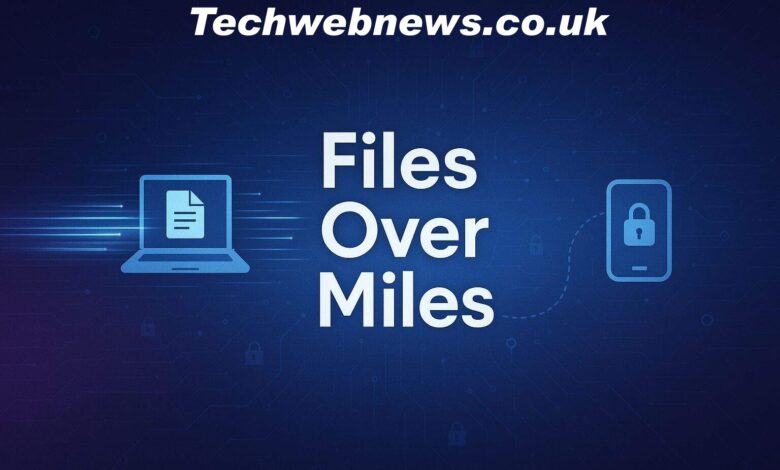Files Over Miles: Revolutionizing File Sharing in the Digital Age

Files Over Miles In a world where speed and convenience dominate our online experiences, file sharing has become a necessity for everyone—from students and remote workers to businesses and creative professionals. While cloud storage giants like Google Drive and Dropbox have been at the forefront, another concept has quietly made waves. The idea behind this tool is simple yet powerful—it allows users to send files directly from one device to another without relying heavily on centralized storage. But what makes Files Over Miles so unique, and why has it gained so much attention among digital users? Let’s dive into the details.
What Is Files Over Miles?
Files Over Miles was an innovative peer-to-peer file-sharing service that changed the way people thought about sending large files online. Unlike traditional methods, which required uploading a file to a server before the recipient could download it, Files Over Miles enabled direct browser-to-browser transfers. This meant that the file didn’t sit on a third-party server, reducing both transfer time and privacy risks.
The beauty of the platform was its simplicity. You didn’t need to install an app, sign up for an account, or go through complicated processes. All you needed was a web browser and an internet connection. You would drag and drop your Files Over Miles into the interface, share the link with your recipient, and the transfer would start instantly as long as both parties stayed online.
For many people, this felt like a breath of fresh air in a digital landscape crowded with login screens, storage limits, and hidden subscription models. Files Over Miles stood out as a user-friendly solution that gave control back to its users.
How Did It Work?

The technology behind Files Over Miles was based on peer-to-peer (P2P) communication, where files travel directly between two connected devices. Think of it as having a direct “digital bridge” that bypasses unnecessary stops along the way.
Traditional file-sharing platforms rely on servers to temporarily store your data, which not only adds delays but also raises concerns about who has access to your files. Files Over Miles avoided this middleman. Once you dropped your file into the platform, it created a unique link that connected the sender and the receiver directly.
This approach also meant there were no artificial restrictions on Files Over Miles size. Users weren’t limited by storage quotas or required to pay extra for sending larger files. As long as your internet connection could handle it, you could send anything—from a few megabytes to gigabytes of data—without interruptions.
Why Was Files Over Miles Popular?
There are plenty of reasons why Files Over Miles resonated with so many people, but three stand out: speed, privacy, and accessibility.
First, speed was a game-changer. Instead of waiting for Files Over Miles to upload to a server and then download again, users enjoyed faster transfer rates. The file moved in real time, directly from one computer to another.
Second, privacy was a major appeal. Since Files Over Miles weren’t stored on a central server, the risk of third-party access or data breaches was much lower. For people dealing with sensitive information, this was a reassuring advantage.
Third, accessibility mattered. You didn’t need technical knowledge or expensive subscriptions to use the service. The fact that anyone with a browser could use it instantly made it widely appealing. It was file sharing stripped down to its most efficient form.
Files Over Miles vs. Cloud Storage Solutions
While Files Over Miles was highly innovative, it existed in a world dominated by cloud storage providers. Services like Google Drive, Dropbox, and OneDrive offered more than just file transfers—they offered collaboration, syncing, and long-term storage. So, how did Files Over Miles compare?
One major difference was in its purpose. Files Over Miles wasn’t designed to store data; it was designed to transfer it. Think of it like handing someone a document directly rather than putting it in a locker for them to pick up later.
Another key difference was convenience in timing. With cloud storage, your recipient could access the file whenever they wanted, even if you were offline. With Files Over Miles, both sender and receiver needed to be online at the same time. While this might seem like a limitation, it also ensured faster and more private exchanges.
Ultimately, Files Over Miles wasn’t competing with cloud storage—it was offering an alternative for people who valued privacy and instant transfers over storage and collaboration.
The Challenges and Limitations
Of course, no system is perfect, and Files Over Miles had its own challenges. The biggest limitation was that both users had to stay online throughout the transfer. If someone lost connection or closed their browser, the process would fail.
Additionally, transfer speeds depended heavily on the quality of each user’s internet connection. While this was true for most file-sharing methods, direct peer-to-peer sharing highlighted these differences even more.
There were also questions of long-term scalability. As the internet grew and new regulations around data privacy and security came into play, maintaining such a lightweight, server-free system became more complex.
The Legacy of Files Over Miles
Even though Files Over Miles is no longer active, its legacy continues to inspire new platforms and technologies. Many modern services have adopted similar peer-to-peer approaches, often integrating them into secure communication tools and enterprise solutions.
For example, technologies like WebRTC now make it possible to send data directly between browsers, and messaging apps often use peer-to-peer methods for faster media transfers. The influence of Files Over Miles can be seen in these innovations, proving that the concept was ahead of its time.
What makes its legacy powerful is how it challenged the status quo. At a time when the internet was leaning more heavily toward centralization, Files Over Miles reminded people of the benefits of decentralization—speed, privacy, and freedom.
Why Peer-to-Peer File Sharing Still Matters Today
Peer-to-peer file sharing continues to play an important role in the digital age, especially with growing concerns around data privacy and corporate control over personal information. People are increasingly aware of where their data goes and who might have access to it. P2P solutions provide an alternative that prioritizes direct communication and reduces reliance on big tech servers.
Files Over Miles may no longer be running, but its philosophy still resonates. In many ways, it paved the way for today’s decentralized technologies, from blockchain systems to secure messaging platforms. Its spirit lives on in tools that challenge the idea that everything must be stored, tracked, and managed by centralized corporations.
Conclusion: Files Over Miles and the Future of File Sharing
Files Over Miles was more than just a file-sharing service—it was a glimpse into what the internet could be: faster, more private, and less centralized. While the platform itself may not be active anymore, its principles continue to inspire digital innovation.
In a world that is becoming increasingly dependent on centralized cloud systems, the philosophy behind Files Over Miles is more relevant than ever. It reminds us that sometimes the simplest solutions—like sending files directly without middlemen—can be the most powerful.
As technology continues to evolve, we can expect to see new platforms that pick up where Files Over Miles left off, combining its strengths with modern features to create even better file-sharing experiences.



